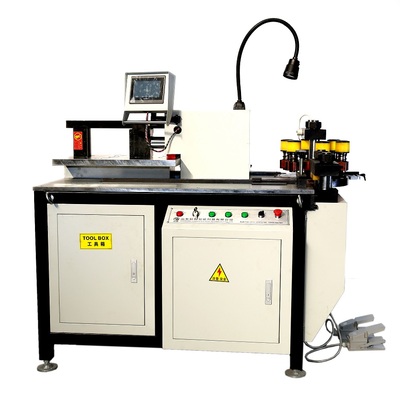Revealing the Secrets of Choosing the Most Suitable CNC Busbar Processing Machine and Tips to Enhance Production Efficiency
As core equipment in the power equipment manufacturing industry, the performance and quality of CNC busbar processing machines directly impact the production efficiency and final quality of products like high-low voltage switchgear and transformers. Faced with a variety of busbar processing machines on the market, selecting one that suits specific production needs has become a challenge for many engineers and business managers. Today, we provide a comprehensive analysis of the technical details of CNC busbar processing machines, key selection points for different industries, and solutions to common problems during use, helping you make informed decisions.

CNC Busbar Processing Machines: More Than Just Punching, Shearing, and Bending
A CNC busbar processing machine is equipment specifically designed for processing copper and aluminum busbars, typically integrating three basic processing units: punching, shearing, and bending, which support independent or coordinated operation. In modern power equipment manufacturing, it has become essential equipment in industries such as high-low voltage switchgear, substations, busway systems, electrical switches, and complete electrical sets.
A multifunctional CNC busbar processing machine often features multiple processing stations and can simultaneously perform various processes like punching, shearing, bending, embossing, flattening, and pressing cable connectors. This multi-station design significantly improves production efficiency, which traditional busbar processing equipment cannot match. By changing the dies, various processing functions such as punching elongated holes, vertical bending, flat bending, embossing, and flattening can be achieved.
Core Technology Analysis: From Basic Functions to Intelligent Upgrades
Shearing Unit: Utilizes a universal double-blade shearing method to ensure clean, burr-free cuts. This design avoids subsequent grinding processes, saving time and labor costs. This is particularly important for businesses that need to process large volumes of busbars daily.
Punching Unit: Modern CNC busbar processing machines often use high-precision five-arm punching die sets or turret structures, which not only extend die life but also provide a clearer operational view, making them more convenient and efficient to use. The turret structure can accommodate multiple dies, allowing for use without frequent die changes, thereby improving work efficiency.
Bending Unit: This is the most technologically advanced part of a CNC busbar processing machine. CNC bending employs two operation methods: traditional bending by directly inputting angle and thickness, and trigonometric function bending by directly inputting the two sides of the right angle, with the hypotenuse length calculated automatically, eliminating manual calculations. Advanced bending units adopt a CNC open bending "cross" frame design, with a 60mm thick steel plate connecting the rear tailstock using inlay and welding processes, greatly enhancing mechanical strength.
Intelligent Development: New generation CNC busbar processing machines are developing towards comprehensive digitization and intelligence. The bending unit features a data memory function, allowing storage and recall of preset parameters. Using PLC control systems coupled with color large-screen displays makes operation more intuitive and straightforward. The built-in password protection function allows modification of unqualified data, and even for non-standard workpieces, data can be set according to requirements for processing.
How to Choose the Most Suitable CNC Busbar Processing Machine Based on Your Industry
High-Low Voltage Switchgear Manufacturing: This is the primary application field for CNC busbar processing machines. For such enterprises, processing accuracy and equipment stability are the top priorities. High-quality CNC busbar processing machines can achieve a punching pressure of 500KN and handle materials with thicknesses of 12-20mm. This processing capacity is crucial for the assembly quality of switchgear.
Transformer Manufacturing Industry: The transformer industry often deals with thicker and wider copper bars, so the processing capacity of the equipment needs attention. When purchasing, confirm the maximum bar thickness and width the equipment can handle. For example, some models can process up to 12mm thick and 160mm wide.
Power Construction Sites: For scenarios requiring frequent mobility, portable CNC busbar processing machines are a better choice. These units integrate punching, shearing, and bending units, adopting a vertical processing method. They are flexible, convenient to operate, and can be used combined or separately, making them ideal for power field emergency repairs.
Large Electric Control Box Manufacturing: For enterprises manufacturing large electric control boxes, the multi-station feature of multifunctional CNC busbar processing machines is particularly applicable. One machine with multiple stations working simultaneously can independently perform various processes like shearing, punching, large bending, small bending (fold-back), embossing, and pressing cable connectors, resulting in extremely high production efficiency.
Key Selection Points: More Than Just Technical Parameters
Core Components Determine Equipment Lifespan: The "heart" of a CNC busbar processing machine is its hydraulic system. High-quality CNC busbar processing machines use hydraulically welded thick steel plate oil tanks treated with phosphating to prevent hydraulic oil from deteriorating over time. Hydraulic hoses use national standard Type A connections, which are durable and easy to maintain. Oil cylinders use international standard cylinder materials to avoid oil leakage after long-term use, ensuring a longer service life.
Processing Precision and Efficiency: Processing precision directly affects product quality, while efficiency determines production capacity. When selecting, it is necessary to balance the relationship between precision and efficiency according to specific product requirements and choose the most suitable model. The market share of high-precision equipment is rising year by year, and efficiency improvement is an important consideration for users when purchasing equipment.
Safety Performance Cannot Be Ignored: The safety of a CNC busbar processing machine is a must-consider factor when purchasing. Quality equipment is equipped with secure foot pedals to control oil inlet and return. Never place hands or any part of the body between the upper and lower dies (blades) during operation to prevent accidents.
Operational Convenience Affects Production Efficiency: For production environments requiring multiple operators, choosing a model that supports multi-person operation is crucial. Such equipment usually requires a dedicated person to direct production, ensuring an orderly processing flow. The user-friendliness of the CNC system is also key; graphical programming can enable new employees to operate independently quickly, effectively reducing training costs.
After-Sales Service Ensures Long-Term Operation: As production equipment, CNC busbar processing machines inevitably encounter failures. Therefore, the supplier's after-sales service response speed is vital. Quality suppliers provide timely after-sales service responses, ensuring the production line isn't halted for long due to equipment failure.
Safety Operation Regulations for CNC Busbar Processing Machines
Before Operation: Fill the oil tank before starting for the first time to prevent damaging the oil pump. Thoroughly read the user manual to familiarize yourself with the machine's structure, performance, and operation methods. If the ambient temperature is below 0°C, idle the machine for a few minutes before work.
During Operation: Installation, debugging (die adjustment, blade gap adjustment), or disassembly of dies must be performed by personnel familiar with the machine according to specified procedures. Never place hands or any part of the body between the upper and lower dies (blades) during operation to prevent accidents. Always select the appropriate shear blade, punch die clearance, and bending radius based on the thickness of the copper or aluminum bar.
After Operation: Follow the sequence to shut down safely: first turn off all unit operation buttons, then the power switch on the control panel, followed by the main circuit air switch, and finally the workshop power switch.
Maintenance and Care: Key to Extending Equipment Life
Regular Inspection: Regularly check the sharpness of the blade and punch die edges. Sharpen or replace them promptly if dull. Keep the oil clean and the oil passages clear; lubricate the moving parts of each unit every shift.
Troubleshooting: CNC busbar processing machines are equipped with many limit switch travels. Over time, the movement characteristics of the moving parts may change, requiring timely inspection, replacement, or adjustment. Ensure electrical and hydraulic components operate flexibly and are positioned correctly; immediately stop and inspect if abnormalities are found.
Future Trends: Simultaneous Advancement of Intelligence and Specialization
With the development of industrial intelligence, CNC busbar processing machines are constantly upgrading. High automation levels in CNC busbar processing equipment can significantly reduce manual intervention, improving production efficiency and product quality. Selecting equipment with an appropriate level of automation according to actual production needs is crucial. Market surveys show that the utilization rate of highly automated equipment in large manufacturing enterprises has reached 70%.
Specialized Customization is another major trend. Addressing the special needs of different industries, CNC busbar processing machine manufacturers are developing models specifically tailored for particular sector requirements. For instance, in the photovoltaic new energy industry, specialized processing equipment has been developed for the characteristics of thin-walled, long-strip, multi-bend busbars, effectively preventing deformation during processing.
Flexible Production capacity has also become a focus of market competition. Modern CNC busbar processing machines, through the CNC system, directly input the busbar thickness and target angle, and the system automatically calculates and executes the bending operation, even achieving one-step forming of complex shapes like Z-bends. This is particularly suitable for small-batch, high-variety production models.
When selecting a CNC busbar processing machine, don't just look at the price; also consider the long-term stability of the equipment and after-sales service. A high-quality CNC busbar processing machine is not just a production tool but a strategic investment for enterprises to improve product quality and enhance market competitiveness. Before deciding, strive for a field trial to intuitively understand the equipment's performance and operational convenience, ensuring the selection of the model that best fits your production needs.


